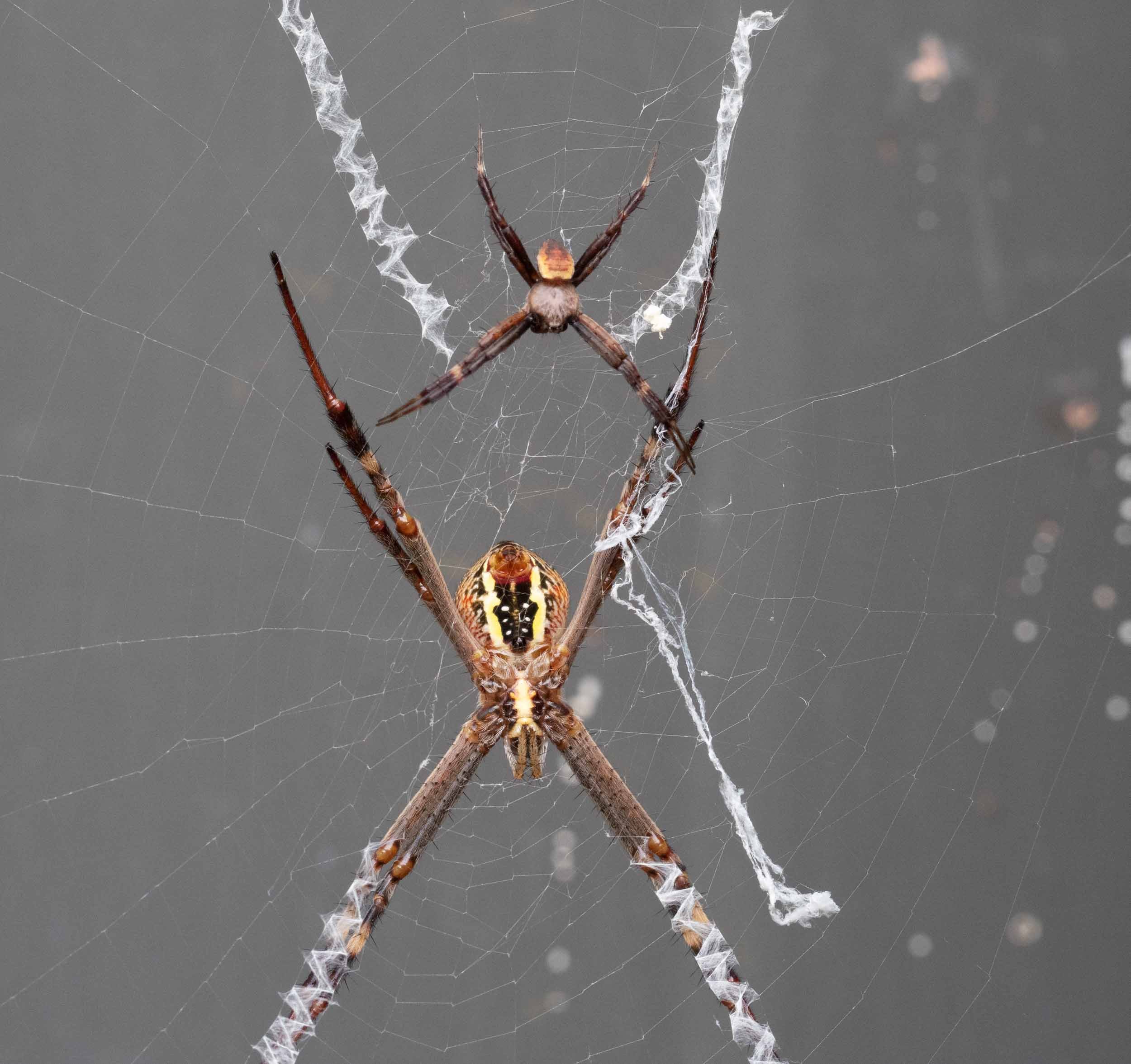Life and death in a web

Reproduction is always a dramatic business - but particularly so for the St Andrew’s Cross spider.
Enticement. Pursuit. Retreat. Struggle. Fulfillment. Death. New life.
We were given a convenient front row seat to this spectacle when a female built her web on our garage wall at the beginning of December. Over the next 6 weeks we witnessed an unfolding drama.
3rd December - setting up home
This is the female Argiope keyserlingi soon after we first noticed her - with her latest catch, a large tabanid fly. She had ensnared it in the orb web constructed by this group of spiders - the classic spider web. Most of the nutrients she extracts from this and other prey items will go towards producing eggs.
6th December - Arrival of the males
We didn’t have to wait long to see the female’s first suitor - a handsome male which we first noticed after he had taken up a position in her web. The marked difference in size between the male and female (sexual dimorphism) is seen in many orb-weaver spiders.
A ventral view of the male shows his swollen pedipalps, the first pair of appendages. The last segment of this limb is modified to form a bulb which functions like a pipette. The male sucks up sperm into this bulb and transfers it to the female’s genital tract with his pedipalps. All spiders use this highly original, ingenious method of copulation. It’s the male spider’s penis ersatz.
Less than 30 minutes after we spotted the first male, a rival appeared on the scene. Male #2 crawled up from the ground a metre below the web, struggling to get a grip on the smooth surface of the garage wall.
But he persevered and eventually reached the female’s web, taking up a position at a respectful distance from male #1.
The near simultaneous arrival of both males may have just been chance. However, it is known that male araneid spiders can detect pheromones released by the female (R. Foelix “Biology of Spiders” 2011).
First advances
Just 10 minutes after entering her web, male #2 made his first advances to the female. These were very tentative. He quickly retreated to the side of the web after barely touching the tips of her hindlegs.
Male #2’s tenure on the female’s web was brief. He was driven away by male #1 soon after approaching the female and was not sighted again.
7th December - repeated male advances towards female
I spent most of this day observing male #1 and the female in the hope of observing a mating event. Over the course of the day the male made several advances to the female.
Here he first wanders around the web over the female, pulling gently on the strands. He then pauses just above her and repeatedly strokes his own legs. This may involve pheromone release and distribution - female spiders are also known to respond to male chemical signals. She remains largely impassive during this whole process.
In this next sequence, the female continuously strokes her abdomen at the site of her genital opening while the male remains stationary above her.
The female now appears to be in a hyper-excited state. The male recognises that he is in danger and becomes much more cautious and passive.
Here the female gets very agitated as the male nears her and chases him to the edge of her web.
While many fascinating interactions between the male and female spider took place on that day, I saw no sign of the actual copulation event.
Over the next few days I continued my “copulation watch” but to no avail. The male kept his distance on a far corner of the web and showed few signs of activity.
13 December - Dénouement
I was always going to need a large dose of luck to be there at the precise time the male inserted his pedipalps into the female’s genital opening.
I came close. I checked the pair of spiders before lunch on this day and they were not obviously interacting.
Then straight after lunch I saw to my dismay that the female had the male in her pedipalps - partially dismembered and wrapped in silk.
I could only guess whether or not the pair had copulated before the male had been captured.
My disappointment was tempered by the knowledge that I had been privileged to observe and record the full mating sequence in this species several years ago.
Over the next 8 days I observed the female spider capturing many sizable prey items. No more males were seen in her web in that time.
On returning from a 2 week holiday break on 6th January, the female was still present. And she proudly displayed an egg sac in the far corner of her web!
So I presume that male #1 had copulated successfully with her before he met his fate on 13th December.
Footnote: As fate will have it, the female spider will not witness the hatching of her progeny. On 13th January, we discovered that a large hole had been ripped in the web and the female was missing. She had presumably made a meal for a bird.
Life and death go hand in hand in the living world!
Postscript: I’m happy to report that even though the central character in this drama - the female Argiope spider - is no longer with us, her genes live on!
On 25th January, Kerri spotted many tiny spiders in the vicinity of the female’s cocoon. Most were bunched tightly together in a cluster about 10 centimetres away from the cocoon, with a few in between. I opened the egg sac up to check they’d all emerged.
I also imaged a number under our high magnification Tessovar macrophotography rig. They’ve got their mother’s eyes, but they’ve a deal of growing up to do!
























